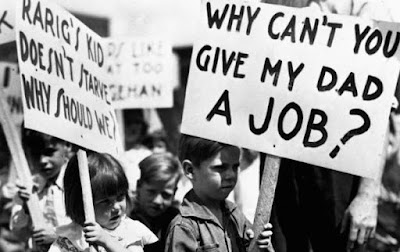The Great Depression - A Brief Summary
The great Depression was the worst economic turn-
WHAT WAS THE REASON BEHIND THE GREAT DEPRESSION?
Many people believe that the Great Depression started with
the stock market crash in October 1929, but its not true and it lends people to
mistake correlation with cause. The Great Depression did begin after the stock
market crash but not because of it.
The economic conditions in U.S were not good prior to the
stock market crash. The 1920’s featured
large scale domestic consumption of consumer products. As most of this consumption
was made by credit and instalment's the economy became unsustainable. Apart from
this, the agriculture sector suffered throughout the 1920’s because of two reasons:
-
- American farms had expanded rapidly during World War I to provide food to a large number of soldiers
- The expansion led many framers to mechanize their operations. As the machinery was expensive many farmers were into debt to finance their expansion.
Another added reason was that by 1925 the growth of car
manufacturing slowed down. According to historian David Kennedy “By 1929,
commercial bankers were in the unusual position of loaning more money for stock
market and real estate investments than for commercial ventures.”
STOCK MARKET CRASH OF OCTOBER 1929
The American economy entered a mild recession during the
summer of 1929, due to which the stock prices began to escalate quickly. As
nervous investors began to sell the overpriced stocks that they held, the Stock
Market crash happened at last on October 24th, 1929. 12.9 million
shares were sold that day, known as “Black Thursday”.
The consumer confidence began to vanish post the stock
market crash and also the down turn in investing and spending led factories and
other businesses to slow down production and increase firing rate of the
workers. For those who still remained employed their wages fell as buying power
decreased.
SINKING OF BANKS AND HOOVER GOVERNMENT
What made the great depression “THE GREAT DEPRESSION” was
massive unemployment which did not begin until 1930.
Only 3% of the American owned stock’s and most of the markets
recovered a lot of their value by 1930, although it did then go down again.
In 1930 a wave of bank failures began happening in various
parts of U.S. As depositors went to take their money out before the banks went
down, the banks called in loans and began to sell assets. Ultimately the credit
froze up. This sole reason really destroyed the country’s economy.
The hoover government stated that the cause of economic
breakdown was World War I, which was true as the war did set stage for a global
economic disaster because of a web of debts and reparations that it created.
For example, under the Treaty of Versailles, Germany had to pay $35 billion in
reparations mostly to France and Britain which it couldn’t pay without
borrowing money from The U.S. In addition, the U.S itself was owed $10 billion
by Britain and France.
Once the American credit dried up as a result of the stock
market crash and bank failures, the economies of Germany, France and Britain
also fell. As the economies of these countries fell, less people abroad could
buy American products or French wines or Brazilian coffee and World trade came
to a halt.
On top of that the
Hoover government (The government which was in US at that time) raised tariffs
on trade with the Hawley Smooth tariff law. The idea of the law was to protect
American industry, but since Europe responded with their own high tariff there
were fewer buyers left for American goods which resulted in less trade, fewer
sales and ultimately fewer jobs.
Hoover didn’t allow the Federal Government to take control
of the situation, which was completely capable of dealing with. By the end of
1931, 2294 American banks had failed, double than that in 1930.
In January 1932, Hoover and Congress created the
‘Reconstruction Finance Co-operation’ under which they borrowed money to
provide emergency loans to banks, building and loan societies, railroads and
agricultural cooperation’s. But this alone wasn’t enough to prevent the
inevitable.
By early 1932 well over 10million people were out of work.
ROOSEVELT CAME TO POWER AND THE NEW DEAL
In 1932 election in U.S democrat Franklin D. Roosevelt won
the elections convincingly and began to work on the economic condition
immediately. He proposed a new set of programs and institutions which came to
be known as the New Deal.
Under the New Deal various dams and hydroelectric project
were undertaken to create more jobs. Also, a new set of financial reforms were
made and new rules were put in to prevent such situation sin the future.
END OF GREAT DEPRESSION AND START OF WORLD WAR II
After the German attack on Poland in 1939, World War II
began, due to which various nations began to expand their defence manufacturing
capabilities producing more and more private sector jobs. Also, the agriculture
sector too saw increase in production. As a result, the unemployment rate began
to decline and eventually the Great Depression ended.





Comments
Post a Comment